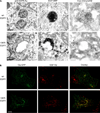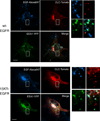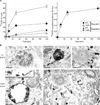The role of EGF receptor ubiquitination in regulating its intracellular traffic
- PMID: 22017370
- PMCID: PMC3261333
- DOI: 10.1111/j.1600-0854.2011.01305.x
The role of EGF receptor ubiquitination in regulating its intracellular traffic
Abstract
Progression of activated EGF receptor (EGFR) through the endocytic pathway regulates EGFR signaling. Here we show that a non-ubiquitinated EGFR mutant, unable to bind the endosomal-sorting complex required for transport (ESCRT) component, Hrs, is not efficiently targeted onto intraluminal vesicles (ILVs) of multivesicular endosomes/bodies (MVBs). Moreover, ubiquitination and ESCRT engagement of activated EGFR are required for EGF-stimulated ILV formation. Non-ubiquitinated EGFRs enter clathrin-coated tubules emanating from MVBs and show enhanced recycling to the plasma membrane, compared to wild-type EGFR.
© 2011 John Wiley & Sons A/S.
Conflict of interest statement
The authors declare that they have no conflict of interest.
Figures







Similar articles
-
SH3YL1 cooperates with ESCRT-I in the sorting and degradation of the EGF receptor.J Cell Sci. 2019 Oct 3;132(19):jcs229179. doi: 10.1242/jcs.229179. J Cell Sci. 2019. PMID: 31492760
-
Roles for ER:endosome membrane contact sites in ligand-stimulated intraluminal vesicle formation.Biochem Soc Trans. 2018 Oct 19;46(5):1055-1062. doi: 10.1042/BST20170432. Epub 2018 Sep 20. Biochem Soc Trans. 2018. PMID: 30242114 Free PMC article. Review.
-
Hrs- and CD63-dependent competing mechanisms make different sized endosomal intraluminal vesicles.Traffic. 2014 Feb;15(2):197-211. doi: 10.1111/tra.12139. Epub 2014 Jan 8. Traffic. 2014. PMID: 24279430 Free PMC article.
-
Membrane contacts between endosomes and ER provide sites for PTP1B-epidermal growth factor receptor interaction.Nat Cell Biol. 2010 Mar;12(3):267-72. doi: 10.1038/ncb2026. Epub 2010 Jan 31. Nat Cell Biol. 2010. PMID: 20118922
-
The relationship between ER-multivesicular body membrane contacts and the ESCRT machinery.Biochem Soc Trans. 2012 Apr;40(2):464-8. doi: 10.1042/BST20110774. Biochem Soc Trans. 2012. PMID: 22435831 Review.
Cited by
-
Endocytosis of receptor tyrosine kinases.Cold Spring Harb Perspect Biol. 2013 May 1;5(5):a017459. doi: 10.1101/cshperspect.a017459. Cold Spring Harb Perspect Biol. 2013. PMID: 23637288 Free PMC article. Review.
-
Intersectin 1 enhances Cbl ubiquitylation of epidermal growth factor receptor through regulation of Sprouty2-Cbl interaction.Mol Cell Biol. 2012 Feb;32(4):817-25. doi: 10.1128/MCB.05647-11. Epub 2011 Dec 12. Mol Cell Biol. 2012. PMID: 22158968 Free PMC article.
-
The Lysosome at the Intersection of Cellular Growth and Destruction.Dev Cell. 2020 Jul 20;54(2):226-238. doi: 10.1016/j.devcel.2020.06.010. Epub 2020 Jun 30. Dev Cell. 2020. PMID: 32610045 Free PMC article. Review.
-
A SPOPL/Cullin-3 ubiquitin ligase complex regulates endocytic trafficking by targeting EPS15 at endosomes.Elife. 2016 Mar 23;5:e13841. doi: 10.7554/eLife.13841. Elife. 2016. PMID: 27008177 Free PMC article.
-
Cell Adhesion Molecules as Modulators of the Epidermal Growth Factor Receptor.Cells. 2024 Nov 19;13(22):1919. doi: 10.3390/cells13221919. Cells. 2024. PMID: 39594667 Free PMC article. Review.
References
Publication types
MeSH terms
Substances
Grants and funding
LinkOut - more resources
Full Text Sources
Other Literature Sources
Research Materials
Miscellaneous

